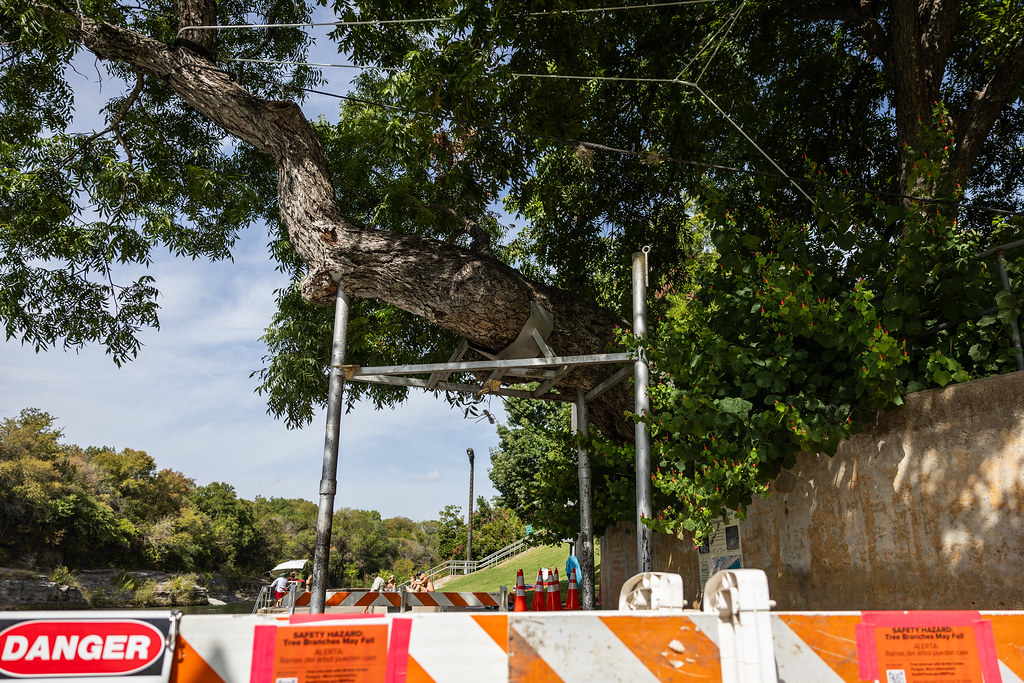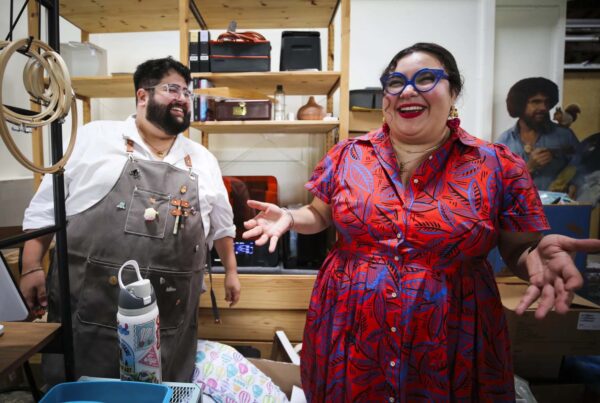Austin Parks and Recreation announced Monday that it is postponing the removal of Flo, the name given to a giant pecan tree on the grounds of Barton Springs Pool, beloved by patrons for generations. The move comes after outcry from some members of the public that the tree must be “saved,” despite recommendations from multiple independent arborists that it be removed for safety reasons.
Last month, city officials revealed the tree was dying from an infection caused by the fungus Kretzschmaria deusta. Commonly known as brittle cinder fungus, the pathogen is more or less a death sentence for trees in which it can gain a foothold.
It’s one of several diseases that can fell even the oldest, most majestic trees in Texas – and they can happen anywhere, including your yard. Texas A&M Forest Service regional urban ecologist Alison Baylis spoke with the Standard about best practices to keep trees healthy, and why some diseases just can’t be treated.
This transcript has been edited lightly for clarity:
Texas Standard: First, can you tell us a little more about this particular fungus, brittle cinder fungus. How common is it, and what does it do to a tree?
Alison Baylis: Sure. So brittle cinder fungus, it’s a white rot that can impact the base and trunk of a number of different types of trees. It spreads through open wounds, as well as connected roots. And what this fungus does is it decays the cellulose within the tree. And that cellulose and loss of cellulose actually causes a rapid loss of strength, which can actually make this a very dangerous type of disease.
Is there anything that can be done with an affliction such as this?
There is unfortunately no treatment for this specific disease, making prevention really key. So things like proper pruning, proper mulching and avoiding wounds – particularly around the base of the tree that could be caused by things like lawn mowers or weed eaters – are all going to be key to preventing this disease.
What’s the general trend in the tree world? Are we seeing more of diseases like brittle cinder fungus and other fungi like it? Less of these? A stable rate? Tough to say?
Well, there’s all different kinds of fungal diseases that can impact trees. There is a very common fungal disease in the Central Texas area called oak wilt, which only impacts oaks. It is, you know, a normal part of an ecosystem to have these fungal disease or decay organisms that go in and really recycle our trees once they’ve reached their end of life. And they play a natural role in the environment.
But when you put those in a landscape setting and you put people into the mix, they can cause issues, particularly around the loss of trees or potentially the falling of trees.
» GET MORE NEWS FROM AROUND THE STATE: Sign up for our weekly newsletters
Is there any relationship between the spread of these types of diseases and the prolonged intense heat we’ve been experiencing this summer?
Yes. So depending on the exact type of fungal disease, a lot of them are actually prevented rather than treated. So things like maintaining tree health and avoiding stress is very important for these types of issues. One of the big stresses that we’re experiencing right now is the drought. So doing things like watering your trees during a drought, if you’re able to, can help them overcome these types of stresses.
Are there particular signs that someone should look out for that say that a tree may be in danger from a disease like brittle cinder fungus?
Well, it depends specifically on the disease. When we talk about brittle cinder fungus specifically, you would want to look for discoloration around the base of the tree. One of the first signs that you may see is actually the fungus itself: It’s sort of a gray-colored fruiting body, and it would have these white edges that eventually can turn black.
Now, that doesn’t go, though, for all tree diseases. In general, what folks would want to look out for is areas of discoloration. Things like wilting leaves or discolored leaves. One of the best things I think a tree owner could do is actually start taking pictures of their trees – take pictures once in the spring, once in the summer, once in the fall. That way you know what’s normal for your tree. And if you see something that doesn’t look normal, those pictures would help you to identify that.
If you were in the market for a tree or trees and you wanted something that was going to be durable, resilient, put up a fight against some of these diseases we’ve been talking about, what are some good options? Are there trees out there that are particularly tough?
So the answer really kind of depends. Typically, our native trees are going to be the most well-adapted to our local environment, but that doesn’t necessarily mean that they are resistant to all the host of diseases that exist.
One of the best things that a tree owner or tree planter can do is actually make sure that we’re planting a variety of different types of trees, as well as having a different age structure of trees – so planting younger trees around older trees. That way, if something does come along and target one of those trees, the diversity can actually help be more resilient.















